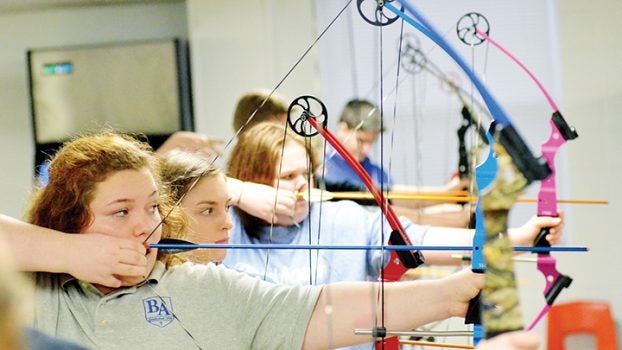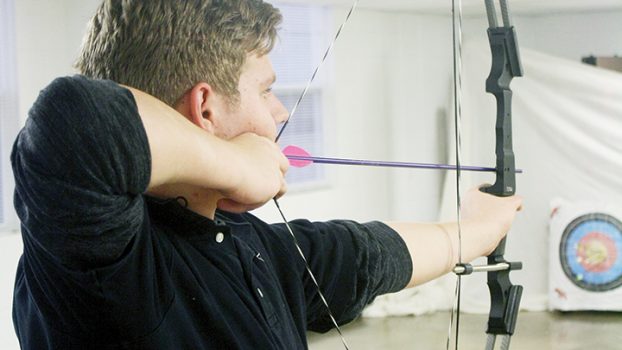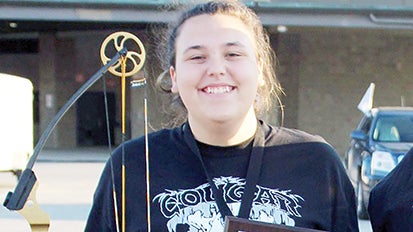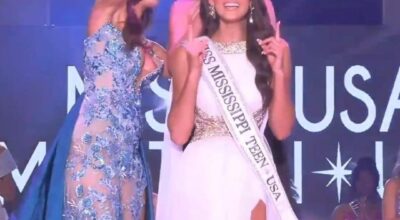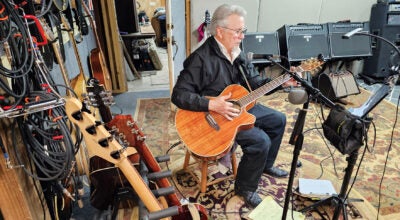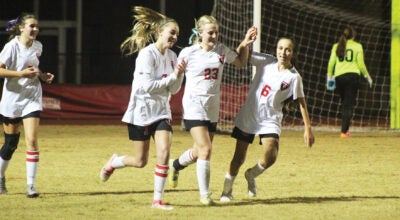Nock, draw, loose — area archery champions aim true
Published 11:23 pm Friday, January 12, 2018
She nocks an arrow on the string and pulls it back, two and one-half feet of sunset orange aluminum with banana yellow fletching.
The bow’s limbs bend back and the cams spin as she draws the string to a stop against her left cheek. She holds it there, eyes open, breathing. Waiting.
She releases. The practice arrow cuts the air and buries in the center of the soft target at the end of the room.
Brookhaven Academy junior Kaitlin Beal lowers her bow and checks her shot. She’s one of her school’s leading archers, and it’s a process she’s completed thousands of times before.
“I’ve always liked archery. When I was young, me and my cousins used to shoot with our little-kid bows,” she said. “I like how archery is a mental game. You have to challenge yourself to do the best you can and be as consistent as you can.”
Beal is one of an estimated 80,000 students who will participate in archery in Mississippi schools this year, a relatively new sport birthed by the Mississippi Department of Wildlife, Fisheries and Parks’ Archery in Mississippi Schools program back in 2005.
It started with 10 schools. Now there are 500. Some of the best programs in the state are in Southwest Mississippi.
The academy, Bogue Chitto, Enterprise, Franklin County, Lawrence County and West Lincoln will all field archery teams this winter and spring, some competing under the established AIMS program and some moving under the umbrella of the Mississippi High School Activities Association. Franklin County was the first archery team in the area and remains strong. Lawrence County has been 4A state champions for five consecutive years.
Good teams are made of good archers. Lawrence County senior Bailey White is the reigning AIMS national champion. She became the best female archer in America last May after shooting a 298 out of 300 at the AIMS national championships in Louisville, Kentucky.
But Lawrence County’s 2018 season isn’t about just her, she said.
“It takes more than one person to win,” said White, who is also a member of her school’s JROTC program. “We have some good shooters. We’ve had several straight out of the gate shoot 290s, and we’ve had several in the high 280s. I feel like we’ll still be No 1.”
The Cougars are under new leadership this year, as long-time championship coach David Barber moved to the coast for a new job. In his place is Lawrence County High School Assistant Principal Tawanna Thornton, who became an archery supporter after her daughter, Mary Beth Thornton, shot for West Lincoln before graduating in 2015.
“I took this position for the kids. Lawrence County has a successful program and we didn’t want to lose that,” she said. “Somebody had to step up.”
Thornton said there is pressure for Lawrence County to continue its dominance. She said some of last year’s shooters aren’t participating this year — some were loyal only to Barber, others took jobs and couldn’t practice, some have balked at new rules for discipline Thornton has instituted.
But the core group of archers — who shot a combined 3,443 points at the state championships last year — remain.
“Archery is very serious in Lawrence County,” Thornton said. “I’m feeling good about my students and where we’re going. They’re willing to set goals and achieve them.”
Franklin County is the area’s other powerhouse. The Bulldogs field three separate teams, one each for their elementary, middle and high schools. All three placed in the top five of their brackets at state last year.
Like Lawrence County, Franklin County’s membership is down this year. Coach Connie Johnston said some students got jobs, others have conflicts with other sports, some have moved outside the county. At least one student had to leave the team because it was conflicting with showing cows.
Franklin County still has a solid group of senior leaders, however, and the losses lead to other blessings.
“When you have smaller numbers, you get to do more one-on-one. I’m pulling in different coaches to help work with the team,” Johnston said. “I want the team to have fun, I want them to enjoy it and I want to see some growth.”
The team would have had to shrink anyway. New MHSAA rules governing AIMS programs have limited team sizes for tournaments down to 24. Previously, larger teams could compete, but only their top scores would count — younger, less experienced shooters could still travel with the team and take part in the competitions, similar to the way cross-country scores top runners.
“We have to cut to 24. I have good shooters in Franklin County, and if you didn’t shoot at least a 270 or 280, you probably wouldn’t have made it,” Johnston said. “Archery is huge now. You have to come out strong. A score of 3,100 used to be enough to win a trophy. Now, you’ve got to have 32, 33, 34.”
The reduced team sizes are unpopular among some coaches. One of those is Brookhaven Academy coach Kelly McDonald.
“There’s not any difference if you only have 12 scorers and 30 or 36 shooters on your team — all those kids can go and compete against themselves,” he said. “Now, those kids who come out there to practice every day, and work all they can, when it comes tournament time, you’re going to tell them, ‘You can’t go to the tournament this week because we can only take 24 and you’re not good enough.’ It ain’t right. This is a mistake. I thought this was supposed to be all about kids getting involved in archery.”
McDonald speculated the reason for roster restrictions is likely the size of the AIMS tournament — more than 5,000 shooters competed in 2017 and the tournament took days. As an independent school, the MHSAA restrictions will not affect BA’s regular archery season, but their team size will be limited in the AIMS tournament.
When tournament time comes, BA should be in good shape. The Cougars finished third in MAIS 3A last year, less than 100 points behind champions Simpson Academy.
“We didn’t have but one graduate off our team. We’ve got the potential to have a really good team this year,” McDonald said. “
Bogue Chitto coach Chad Norton said the new MHSAA rules aren’t really affecting the Bobcats. Since the school’s team formed five years ago, they’ve only taken 25 or so shooters to matches, anyway. He has around 30 members this year, including senior Chaney Rutland, who qualified for the all-star shoot last year.
“It makes it all uniform. MHSAA is going to recognize a champion this year,” he said. “Just like in football, you can only put 11 people on the field at one time. Only five people on the basketball court at one time. You can sub in and out from the bench, and that’s the same way you can do under the MHSAA rules.”
Even without MHSAA, Norton purposefully controls his team size to make sure students with few other opportunities get to draw a bow.
“I try not to let any of those baseball and softball kids participate in archery. They have to choose,” he said. “I want kids who are going to be at the practices, and I want them to be kids who probably aren’t going to participate in anything else.”
Just down the road is Enterprise, where coach Shane Jordan’s archers won south state in 2017 and came in sixth place in the state tournament, just two points behind West Lincoln. He has 29 shooters this season and most of them are experienced.
“We should be in store for a good year,” he said. “The kids here are good at what they do.”
It may be easy to assume all the Southwest Mississippi archers were raised as hunters familiar with a bow. That’s not the case in Enterprise, or anywhere, really.
“Ninety percent of my kids have never picked up a bow. When it comes to archery, it’s not about whether you’ve done it before,” Jordan said. “If you master the techniques, anybody can shoot. When you do get a student who has hunted before it comes to them a lot more natural, but I have kids who can pick up a bow and bull’s-eye on the first shot.”
West Lincoln has seasoned shooters returning this year. Coach Luke Addison said juniors Caleb Weeks, Dalton West, and brothers Will and Nathan Gary trade the team’s top spot back and forth, and freshman Barrett Boyd excelled in the junior ranks last season.
“Our team has gotten to be real competitive,” Addison said. “We have some young shooters who are going to help out as well. They work hard, and once they start shooting a lot of arrows, they’ll start learning how to group them together and that’s what it takes.”


